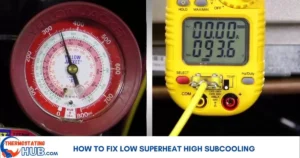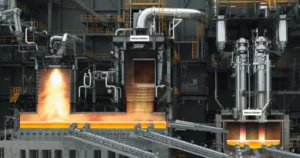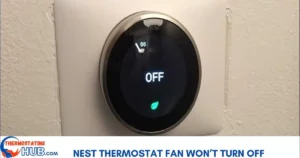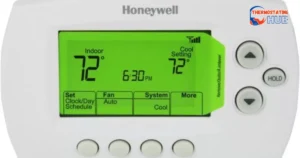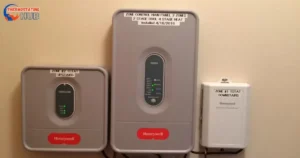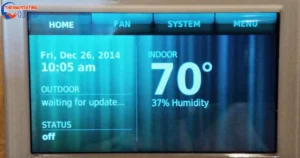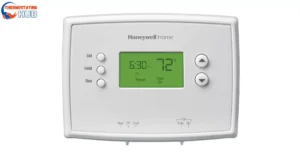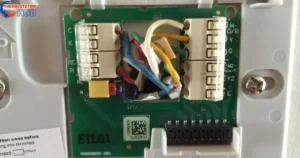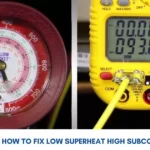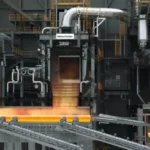Is your Sensi thermostat blowing cold air when it’s set to heat? If that’s the case, this guide is just what you need! Several factors could be causing your Sensi thermostat to blow cold air instead of heat.
This guide will explore the most common issues that might be the culprit.
Usually, when your Sensi thermostat is set to heat but is blowing out cold air, it could be because of incorrect thermostat settings, a stuck reverse valve, improper thermostat wiring, ignition failure, clogged condensate lines, and a few other potential issues we’ll cover in this guide.
Remember to check the specific thermostat settings and wiring connections. Sometimes, a simple adjustment can resolve the issue!
Possible reasons your Sensi is blowing cold air on heat
| Possible Cause | Fix |
| Sensi set to fan ‘on’ | Put the fan setting to auto |
| The heat pump reverse valve stuck on the cool | Set the thermostat to heat (for heat pump) |
| Wrong thermostat wiring | Check wiring and wire it correctly |
| Ignition failure | Check furnace |
| Dirty flame sensor | Clean/replace flame sensor |
| Damaged ductwork | Seal off leaky ductwork |
Potential Fixes: Ensuring the correct settings and addressing issues like wiring, sensors, and ductwork can resolve most of the problems causing your Sensi thermostat to blow cold air instead of heat. Regular maintenance can prevent future issues!
1) Incorrect thermostat setting
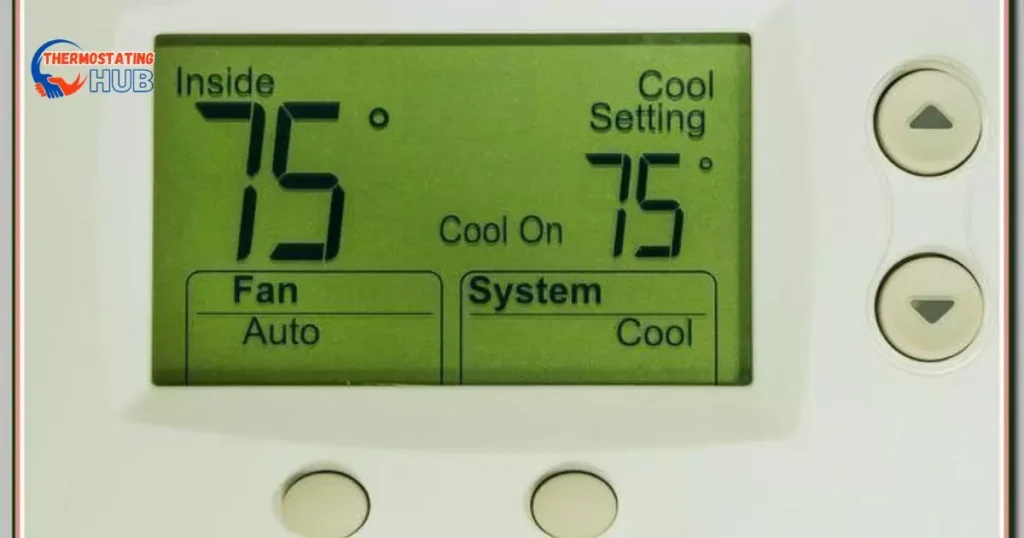
One of the most straightforward reasons for your Sensi thermostat blowing cold air on the heat setting might be an incorrect setting on the device itself. Check to ensure that the thermostat is set to “heat” and not accidentally set to “cool” or “off.” Sometimes, simple human error or accidental adjustments can cause this issue.
One of the most common reasons a Sensi thermostat may blow cold air in heat mode is when the thermostat’s fan setting is set to ‘ON’ instead of ‘auto‘ or ‘heat.’ When the fan is set to ‘ON,’ it keeps blowing air continuously, even during the thermostat’s cooling cycle, resulting in the air from the vents feeling cold.
Another possibility could be forgetting to switch between heating and cooling modes.
Solution:
To resolve this issue, check your thermostat settings. Ensure the fan setting is on ‘auto’ or ‘heat.’ If it’s set to ‘ON,’ adjust it accordingly to prevent continuous cold airflow.
Double-check your Sensi thermostat’s settings. Ensure it’s switched to the heat mode. If you notice it’s set incorrectly, switch it to the desired heat setting and wait for a few minutes to see if the issue resolves. 🙋
2) Stuck Reversing Valve
A stuck or malfunctioning reversing valve could also lead to your Sensi thermostat blowing cold air. The reversing valve changes the refrigerant flow direction in your HVAC system. If it gets stuck or fails to switch to the heating mode, it can cause the system to blow cold air instead of warm.
A potential reason for your Sensi thermostat not heating could be a stuck reverse valve. The reverse valve alters the refrigerant’s direction, allowing the heat pump to either cool or heat your home, depending on the season.
If this valve becomes stuck in one direction, it can cause irregularities. It may result in either cooling during both heating and cooling modes or heating during both cooling and heating modes.
Solution:
If you think your reversing valve isn’t working properly, it’s a good idea to ask an HVAC expert to take a look.
A stuck reversing valve often happens because the solenoid is burned or damaged inside it. This part can be easily replaced. They can assess the valve’s condition and repair or replace it if necessary, restoring proper functionality to your heating system.
3) Wrong thermostat wiring:
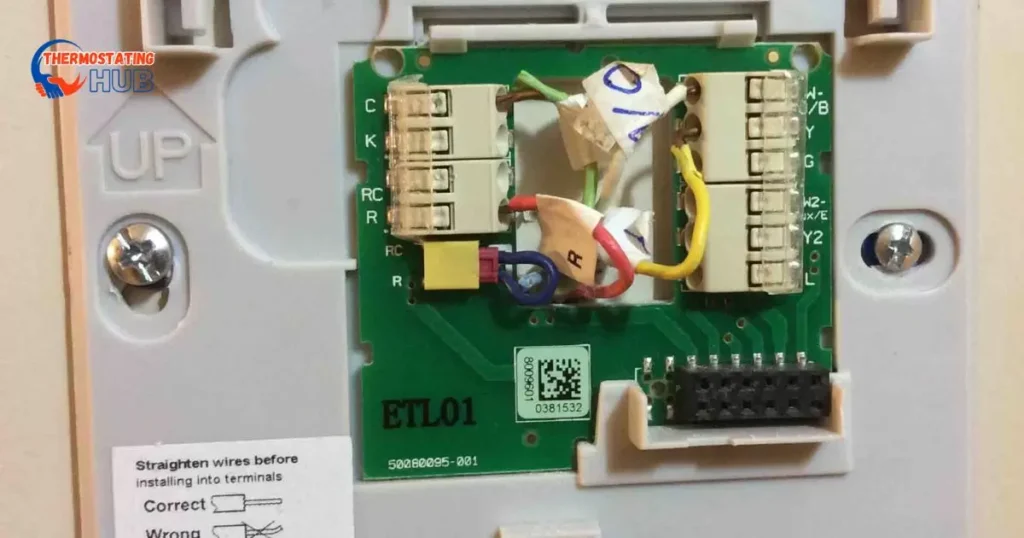
Did you recently install a new thermostat? Did the heating work fine with the old thermostat? If yes, the issue might be because the wiring of the new thermostat is incorrect, which could be why your Sensi thermostat isn’t producing hot air.
Incorrect wiring during the installation or any recent adjustments to the thermostat could result in your Sensi thermostat blowing cold air. This issue commonly arises if the wiring doesn’t match the required configuration for your heating system.
Solution:
When you connect the wires to your thermostat, be sure to put each wire in the right place that matches the heating or cooling system you have (like a regular one or a heat pump).
If your old thermostat has wires connected to these specific groups of terminals—1, 2, 3, 4; A, B, C, D; V+, VG, RS-, RS+; R, 1, 2, C—then the Sensi thermostat won’t work with your system.
Ensure the ” OB ” wire is connected correctly to the “OB picker.”
Carefully examine the thermostat wiring or consult the installation manual to ensure the correct wiring setup. If there’s a discrepancy, rewire the thermostat according to the manufacturer’s instructions or seek assistance from a certified technician.
4) Ignition Failure
When your furnace doesn’t start, it won’t create flames to warm the air, so your home won’t get heated. This issue isn’t because of your thermostat but because of the furnace itself.
Even if the fan works fine, no warm air will come from the vents. The problem with the furnace not starting could happen because of insufficient fuel, a dirty flame sensor, or the gas supply being turned off.
One possible cause of cold air from your Sensi thermostat when set to heat is ignition failure. If the ignition system malfunctions in a gas furnace, it can’t ignite the burner, blowing cold air instead of warm air.
Solution:
Go to your furnace and see how it’s doing. First, check if the gas valve is open. It needs to be open so enough gas can reach the burners. If it’s been a long time since you last filled your gas tank, ensuring there’s still enough gas in it is a good idea.
To fix this, first, ensure the thermostat is set to heat, and the temperature is adjusted above the current room temperature. Check the furnace’s pilot light. If it’s out, follow the manufacturer’s instructions to relight it carefully. Additionally, inspect the furnace’s electrical connections and consult a professional if needed to fix any ignition-related issues.
5) Dirty/Defective Flame Sensor:
Your heater might not turn on if the flame sensor is dirty. Flame sensors help the heater work safely by checking if there’s a flame where the fuel burns.
When there’s a flame, the sensor keeps the fuel valve open. But if there’s no flame, it closes the valve to stop gas from entering your home, which could be dangerous.
As the sensor gets older, dirt or soot can build up on it. Too much of this can stop it from sensing the flames, stopping the heater from turning on. This leads to no heating and might be why your Sensi (heater) is blowing cold air.
Another potential culprit for your Sensi thermostat blowing cold air during the heat cycle could be a dirty or defective flame sensor.
The flame sensor is a safety device in your furnace that detects the presence of a flame. If it’s dirty or malfunctioning, it might not detect the flame, causing the furnace to shut off the burner.
Solution:
You can check if your furnace’s flame sensor works by looking at it. If it looks dirty, you can clean it with sandpaper, but turn off the power to your heating system first.
If cleaning the sensor doesn’t solve the issue, you might need to buy a new one. But only do this if you’ve checked the sensor to ensure it’s causing the problem and tested it to see if it’s working correctly.
- Begin by turning off the furnace and letting it cool down.
- Locate the flame sensor and gently clean it using an emery cloth or fine-grit sandpaper to remove buildup.
- After cleaning, reinstall the sensor and restart the furnace.
- If the issue persists, consider contacting a technician to inspect and possibly replace the flame sensor.
Read More Article: Furnace Running But Not Blowing Air
6) Damaged Ductwork:
When the pipes that carry warm air in your house are broken, the heat can leak out, and cold air can come in. This makes a mix of warm and cold air, which can make the air in your home cooler overall.
Sometimes, the problem of cold air blowing from your Sensi thermostat during heating cycles can stem from damaged ductwork. Holes, leaks, or disconnected duct sections can allow warm air to escape before reaching your living spaces, causing the sensation of cold air blowing from the vents.
Solution:
Check your ducts for any holes or damage. If you find any, cover them up properly or get a professional who knows about heating and cooling systems to assist you. The places where the ducts connect are often where holes happen. Look closely at those spots to make sure they’re okay.
Inspect your ductwork visually, checking for any visible damage or disconnections. Seal small leaks or holes using duct tape or mastic sealant. For more extensive damage, contacting a professional HVAC technician is advisable to repair or replace the damaged ducts properly.
Future Scope
The ongoing advancements in smart home technology, including thermostats like the Sensi, indicate a promising future in heating and cooling systems. As technology continues to evolve, several aspects can be envisioned for the future of thermostats and HVAC systems.
Enhanced Smart Features
Future iterations of smart thermostats, such as the Sensi, might incorporate even more advanced features. These could include improved sensors for better temperature accuracy, machine learning algorithms that adapt to user preferences automatically, and enhanced connectivity with other smart home devices for seamless integration and control.
Energy Efficiency
A significant focus in the future of thermostats is on enhancing energy efficiency. Advanced algorithms and AI could enable thermostats to optimize heating and cooling schedules based on occupancy patterns, weather forecasts, and individual preferences, thereby reducing energy consumption and utility costs.
Integration and Interoperability:
The future of smart thermostats might involve increased compatibility and integration with other smart home devices and systems. This could allow for comprehensive home automation, where thermostats work with lighting, security, and other systems to create a more cohesive and efficient home environment.
Health and Air Quality Monitoring
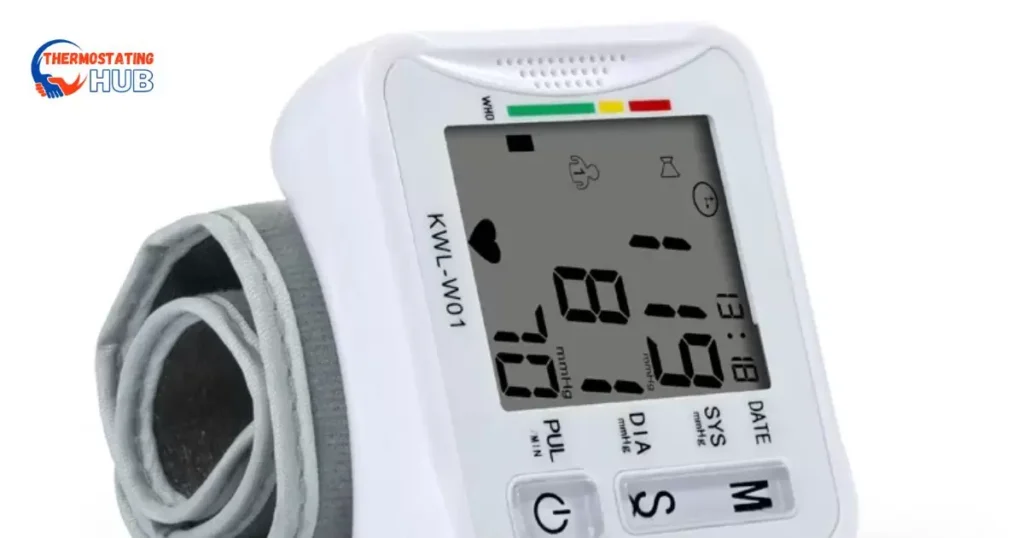
There’s a growing interest in incorporating features that monitor indoor air quality and contribute to healthier living spaces. Future thermostats could integrate air quality sensors to detect pollutants, allergens, and other contaminants, providing insights and alerts to improve indoor air quality.
Sustainability Initiatives
With a growing global focus on sustainability, future thermostats might incorporate eco-friendly features and support sustainable HVAC practices. This could involve compatibility with renewable energy sources, such as solar panels or geothermal heating, to reduce carbon footprints.
Artificial Intelligence and Predictive Maintenance
Integrating AI could lead to predictive maintenance capabilities in thermostats. These systems could analyze performance data to predict potential issues before they occur, allowing for proactive maintenance and reducing the likelihood of unexpected breakdowns.
User Interface and Accessibility
Future thermostats may feature more intuitive user interfaces, catering to a broader demographic range. This could include easier-to-use interfaces, voice-activated controls, and improved accessibility features for individuals with diverse needs.
Pros:
- Energy Efficiency: Sensi thermostats offer energy-saving features that enable users to create schedules and adjust settings to optimize energy consumption, leading to potential cost savings on utility bills.
- Smart Technology Integration: These thermostats seamlessly integrate with smart home systems and devices, allowing users to control them remotely via smartphone apps or voice assistants like Alexa or Google Assistant.
- Easy Installation: Designed for simple installation, Sensi thermostats are often compatible with a wide range of HVAC systems, making them an accessible choice for DIY installation.
- Customizable Settings: Users can customize temperature settings, create schedules, and adjust preferences to suit their heating and cooling needs.
- Compatibility: Sensi thermostats are typically compatible with various HVAC systems, offering versatility and suitability for multiple households.
Cons:
- Compatibility Issues: Despite their broad compatibility, some users may need help with older or less common HVAC systems that Sensi thermostats might not fully support.
- Reliance on Wi-Fi: The remote control and smart features depend on a stable Wi-Fi connection. Interruptions in internet service or weak signals can result in loss of remote access and control.
- Price: While cost-effective in the long run due to potential energy savings, the initial purchase cost of a Sensi thermostat might be higher compared to traditional thermostats.
- Limited Features: Some users might find the features offered by Sensi thermostats to be basic compared to more advanced smart thermostats, lacking specific advanced sensors or predictive capabilities.
- Technical Issues: Like any electronic device, Sensi thermostats can encounter technical glitches or software issues that may require troubleshooting or assistance from customer support, potentially causing inconvenience to users.
Answer To Key Questions:
Why is my Sensi thermostat blowing cold air?
If your Sensi thermostat is blowing cold air, it may be due to various reasons, such as incorrect thermostat settings, a malfunctioning heating system, or issues with the thermostat wiring. Check the thermostat settings, inspect the heating system, and consider consulting the Sensi thermostat manual or reaching out to customer support for assistance.
Why is my thermostat on heat but blowing cold air?
Issues like a malfunctioning furnace, a faulty thermostat, or problems with the heating system components could cause a thermostat to heat but blowing cold air. It’s advisable to check the thermostat settings, inspect the heating system, and consult with an HVAC professional for a thorough diagnosis.
Why is cold air coming out when I turn heat on?
Cold air coming out when you turn on the heat may indicate issues such as a malfunctioning furnace, a problem with the thermostat, or issues with the heating system components. Inspect the system and consider consulting with an HVAC professional for proper diagnosis and repair.
Why won’t my Sensi thermostat turn to heat?
If your Sensi thermostat doesn’t switch to heat, it could be due to various reasons, including incorrect settings, a malfunction in the thermostat, or wiring issues. Check the thermostat settings, ensure proper wiring, and consult the Sensi thermostat manual or customer support for guidance on troubleshooting and resolving the issue.
Final Thoughts:
Now that you know why your Sensi thermostat might blow cold air when it’s supposed to be warm, we hope we’ve solved this issue. If it’s still not working correctly, we suggest you contact nearby heating and cooling experts for assistance.
Experiencing your Sensi thermostat blowing cold air when it should be heating your home can be a bothersome issue, but it’s often fixable. Ignition failure, a dirty or defective flame sensor, or damaged ductwork are common culprits.
Always prioritize safety by following manufacturer guidelines and, if necessary, seek professional assistance to ensure your heating system operates efficiently and effectively. With these troubleshooting steps, you can hopefully resolve the issue and enjoy the warmth and comfort of a properly functioning heating system.
Thank you for taking the time to read this article! If you have any additional questions or need more help, please don’t hesitate to ask. I appreciate your engagement! 📚😊

Ethan Richards here, your HVAC virtuoso at “Thermostating Hub.” From battling summer heat to conquering winter chills, I bring a wealth of HVAC knowledge. Let’s ensure your system runs smoothly, creating the ideal indoor climate for you.
![Sensi Thermostat Blowing Cold Air On Heat [Fixed]](https://thermostatinghub.com/wp-content/uploads/2023/12/sensi-thermostat-blowing-cold-air-on-heat-fixed.webp)



